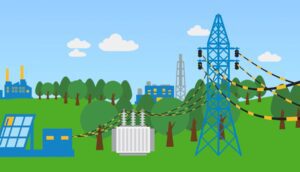From a simple flip of the light switch to charging multiple devices beyond just your cell phone, electricity is a constant of modern life. And while we depend on it continually, we don’t often think about where our power comes from. But the reality of the grid is surprisingly complex, and it’s evolving fast.
Where does Central Florida get its electricity? Thomas Edison built the first central power station in 1882. Since then, power generation has evolved, from steam to diesel, later coal, nuclear and natural gas. Today, coal and gas are the leading forms of generation across much of America – Florida included. Currently, wind, hydroelectric and geothermal are not economically and/or technically viable in Florida – and biomass and landfill gas, while possible resources, are available only in small quantities. Looking forward, OUC is paving the way for a greener future using a diverse portfolio of energy sources including natural gas and solar. As other sources become available, those too will be considered in our energy mix. Not only are these options allowing us to move closer to our goal of Net Zero CO2 Emissions by 2050, with interim reductions of 50% by 2030 and 75% by 2040, the diversification ensures a more resilient system for our customers.
 How does electricity get from place to place? Before large amounts of energy can be transmitted quickly across Central Florida, its voltage – the pressure of its electric current – must be increased. OUC redirects electricity through centralized substations, where large-scale transformers “step up” the voltage to extremely high levels.
How does electricity get from place to place? Before large amounts of energy can be transmitted quickly across Central Florida, its voltage – the pressure of its electric current – must be increased. OUC redirects electricity through centralized substations, where large-scale transformers “step up” the voltage to extremely high levels.
That powerful electric current travels across transmission lines to local distribution substations, where the voltage is “stepped down” for regional use. Finally, electricity is stepped down once again through small transformers attached to power lines before it reaches your home or business.
How is the grid changing, and what will it look like in the future? Nearly 70% of Florida’s electricity comes from natural gas. That gas is delivered via a pipeline that runs the length of the peninsula to centralized power plants. Due to Florida’s geographical positioning as a peninsula, Florida can import natural gas only from its northern border, unlike other states.
As Florida’s population grows, and the demand for electricity increases, utilities like OUC are reimagining the traditional grid. Instead of relying on centralized power plants that distribute electricity across the state, the new grid will need to be decentralized, incorporating many smaller generation points – from solar panels paired with energy storage to peaker plants (plants that only run when there is a high energy demand) – to provide a more sustainable and resilient network of energy.
As the landscape of energy changes rapidly, there’s no better time to get to know the infrastructure that will power Central Florida for years to come. To find out more about how OUC keeps your power running smoothly, visit www.OUCBlog.com.


